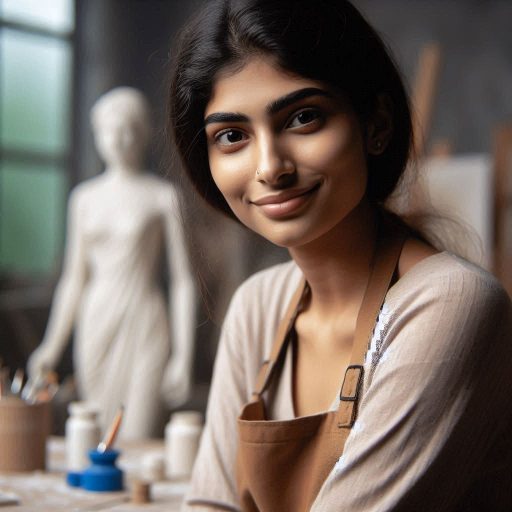Introduction
Glass art has a rich history, dating back thousands of years to ancient civilizations.
It began as simple glass beads and evolved into intricate pieces of craftsmanship.
From early Mesopotamian glasswork to Roman innovations, glass art has continually transformed.
Over time, artisans discovered new techniques, such as blowing and stained glass, which expanded the possibilities of this unique art form.
The history of glass art starts around 3,500 BCE in Mesopotamia and Egypt.
Early glassmaking was used primarily for decorative objects and small vessels.
The Romans revolutionized the art by introducing glassblowing in the first century BCE, allowing for more complex and larger creations.
During the Middle Ages, stained glass windows became prominent in cathedrals across Europe, showcasing religious stories through vibrant colors.
The Renaissance period brought advancements in Venetian glassmaking, which elevated glass art to new levels of craftsmanship.
In the modern era, glass art continues to evolve with contemporary artists experimenting with new techniques and materials, pushing the boundaries of traditional glasswork.
Glass art has played a significant role in cultures worldwide.
Ancient Egyptians used glass to create decorative amulets and jewelry, believing it held protective properties.
In Islamic cultures, glasswork flourished in architecture, creating intricate designs in mosques and palaces.
In Europe, stained glass windows told religious stories, influencing spirituality and culture.
Venetian glass was a symbol of luxury and status during the Renaissance, reflecting society’s appreciation for artistry.
Today, glass art continues to inspire, bridging tradition and innovation across global cultures, with modern pieces showcasing the diversity and creativity of artisans worldwide.
Ancient Origins of Glass Art
Glass art has ancient roots, with its earliest known forms emerging in Mesopotamia and Egypt around 2500 BCE.
In Mesopotamia, artisans first experimented with glass beads and vessels, marking the beginning of glass craftsmanship.
Egyptian artists also played a significant role in early glass art, producing vibrant glass inlays and ornaments.
The earliest known forms of glass art, dating back to ancient Mesopotamia and Egypt
Early glassmaking techniques were simple but effective.
Transform Your Career Today
Unlock a personalized career strategy that drives real results. Get tailored advice and a roadmap designed just for you.
Start NowOne of the most common methods used by these civilizations was core-forming.
This process involved shaping a core made of clay and covering it with molten glass to create vessels.
After cooling, the clay core was removed, leaving behind a hollow glass object.
This technique allowed artisans to craft beautiful and functional glass items.
Ancient civilizations also employed a technique called casting, where molten glass was poured into molds to form intricate designs.
This method enabled the production of detailed glass objects, including figurines and decorative panels.
The development of glass cutting tools and polishing techniques further refined these early glassworks.
The techniques and tools used by early civilizations to create glass art pieces
Tools like blowpipes, which were later introduced by the Romans, were not yet available to ancient Mesopotamians and Egyptians.
However, they used simple tools like paddles, tongs, and knives to manipulate molten glass.
These tools allowed them to create detailed patterns and shapes, showcasing their creativity.
The vibrant colors seen in ancient glass art were achieved by adding various metal oxides to the glass mixture.
These colors, combined with skilled craftsmanship, resulted in breathtaking art pieces that have endured for millennia.
The earliest forms of glass art laid the foundation for future innovations, paving the way for the advanced glassmaking techniques we know today.
This rich history highlights the ingenuity and artistry of early civilizations in shaping glass art’s evolution.
Read: The Sculptor’s Journey: Pathways to an Artistic Career
Development of Glassblowing
Glassblowing, invented in the 1st century BCE in the Eastern Mediterranean, transformed the art of glassmaking.
This technique allowed artisans to shape molten glass by blowing through a tube, offering greater flexibility in design.
Prior to this invention, glass objects were laboriously cast or shaped, limiting their forms and uses.
Glassblowing revolutionized glass production, making it faster and more efficient.
As a result, glass objects became more accessible to a wider audience.
Transform Your Career Today
Unlock a personalized career strategy that drives real results. Get tailored advice and a roadmap designed just for you.
Start NowThe invention of glassblowing in the 1st century BCE and its impact on the evolution of glass art
The introduction of glassblowing led to the rapid spread of glass art across the Roman Empire.
Artisans could now create intricate and delicate designs, previously impossible with older techniques.
Glass vessels, such as jars, cups, and vases, could be made more quickly and with less material.
This significantly lowered production costs while enhancing the range of artistic expression.
The ability to mass-produce glass vessels made them popular for everyday use.
In addition to practical items, glassblowing also paved the way for the creation of decorative objects.
Colored glass and intricate patterns became more common, showcasing the versatility of the medium.
Artisans experimented with new shapes and designs, producing beautiful glass sculptures and ornaments.
The technique’s ability to capture light added a unique aesthetic value to these creations.
How glassblowing revolutionized the production of glass vessels and decorative objects
As glassblowing spread, it stimulated the growth of glassmaking centers in places like Rome, Alexandria, and later, Venice.
These centers became hubs of innovation, pushing the boundaries of what was possible in glass art.
The invention of glassblowing marked a pivotal moment in the history of glass art, influencing its evolution for centuries to come.
It remains a cornerstone of glassmaking techniques, celebrated for both its functionality and artistic potential.
Create stunning works of art that continue to captivate audiences to this day.
Read: The Artist’s Guide to Printmaking Supplies
Renaissance and Baroque Period
Flourishing of glass art during the Renaissance and Baroque periods in Europe
The Renaissance and Baroque periods marked a significant flourishing of glass art in Europe.
During the Renaissance, artisans began experimenting with new techniques and styles, elevating glassmaking to a sophisticated art form.
Italian glassmakers, especially those in Venice, played a critical role in advancing these innovations.
They developed methods like millefiori, filigree, and enamel painting, which transformed glass into a canvas for intricate designs.
The Baroque period further expanded glassmaking’s artistic reach.
Transform Your Career Today
Unlock a personalized career strategy that drives real results. Get tailored advice and a roadmap designed just for you.
Start NowBaroque art emphasized grandeur and emotion, and glassmakers adopted these principles into their creations.
Elaborate, highly decorative glass pieces became popular, with a focus on ornamental details and bold designs.
The use of color and complex patterns also became central to the era’s glassworks, particularly in stained glass.
Key artists and glassmaking centers that contributed to the development of glass art during this time
Key artists and centers significantly shaped glass art during these periods.
The island of Murano in Venice became the heart of glass innovation.
Murano glassmakers, like the Berovier family, gained international recognition for their mastery of techniques such as cristallo, which produced incredibly clear and fine glass.
Other important centers included Bohemia, where glassmakers specialized in cutting techniques, and Germany, known for its engraved glass.
Renowned glass artists like Angelo Barovier and the Nason family brought glassmaking to new heights with their expertise and creativity.
They were instrumental in refining glassblowing and developing distinctive styles that became sought after across Europe.
Their works set the standard for centuries and solidified glass art’s place in the fine arts.
Overall, the Renaissance and Baroque periods laid the foundation for modern glassmaking, with their innovations continuing to inspire contemporary artists today.
Read: Printmaking: Combining Traditional and Digital

Industrial Revolution and Modernization
The impact of the Industrial Revolution on glassmaking techniques and mass production of glass art
The Industrial Revolution significantly transformed glassmaking techniques, leading to advancements in production.
Before this period, glassmaking was largely done by hand, limiting output.
However, the advent of mechanized processes in the late 18th century enabled mass production.
These innovations allowed glass to be produced more quickly and at lower costs.
Glassmakers used new methods, such as pressing and molding, to create intricate designs with greater precision.
As a result, glass art became more accessible to the masses, rather than being a luxury for the wealthy.
During this time, the demand for decorative glass items surged.
Factories produced glass for both functional and artistic purposes.
Transform Your Career Today
Unlock a personalized career strategy that drives real results. Get tailored advice and a roadmap designed just for you.
Start NowStained glass windows and ornate glassware adorned homes, cathedrals, and public buildings.
The ability to produce glass in large quantities also led to new artistic possibilities.
Artists could now experiment with different colors, textures, and shapes.
This era marked the shift of glass from purely functional to both functional and artistic.
The rise of modern glass art movements, such as Art Nouveau and Studio Glass
The rise of modern glass art movements, such as Art Nouveau, further enhanced the role of glass in art.
Art Nouveau, emerging in the late 19th century, emphasized flowing, organic forms inspired by nature.
Artists like Louis Comfort Tiffany revolutionized stained glass design, combining intricate patterns with vibrant colors.
Later, in the mid-20th century, the Studio Glass movement emphasized individual craftsmanship.
Artists like Dale Chihuly created striking sculptures that redefined glass as an expressive medium.
This period highlighted the resurgence of glass as a prominent art form, blending modern techniques with traditional craftsmanship.
The Industrial Revolution laid the foundation for these modern movements, showcasing how glass could merge artistic beauty with industrial efficiency.
Read: Exploring Cultural Influences in Printmaking
Contemporary Glass Art
The Diverse Styles and Techniques in Contemporary Glass Art
Contemporary glass art has evolved into a rich and diverse field, encompassing various styles and techniques that push the boundaries of traditional glassmaking.
From intricate sculptures to immersive installations, contemporary glass artists continue to experiment and innovate in this dynamic medium.
One prominent style in contemporary glass art is the use of mixed media, where artists combine glass with other materials such as metal, wood, or even found objects to create unique and visually striking pieces.
This blending of materials adds complexity and depth to the artwork, challenging viewers to reconsider their perceptions of glass as a medium.
Sculpture is another prevalent form within contemporary glass art, with artists creating three-dimensional works that range from small, delicate pieces to large-scale installations.
Sculptural glass art often explores themes of nature, human emotion, and the subconscious, inviting viewers to engage with the work on a tactile and emotional level.
Prominent Contemporary Glass Artists and Their Contributions
One of the leading figures in contemporary glass art is Dale Chihuly, known for his bold and colorful glass sculptures that are often displayed in large-scale installations.
Chihuly’s work combines traditional glassblowing techniques with innovative forms and vibrant colors, creating immersive environments that captivate audiences worldwide.
Transform Your Career Today
Unlock a personalized career strategy that drives real results. Get tailored advice and a roadmap designed just for you.
Start NowAnother influential artist in the field is Lino Tagliapietra, a master glassblower who has revolutionized the medium with his intricate and technically challenging creations.
Tagliapietra’s pieces push the boundaries of what is possible with glass, showcasing the material’s versatility and beauty in ways that are both innovative and breathtaking.
Contemporary glass artist Beth Lipman is renowned for her intricate and symbolic glass installations that explore themes of memory, loss, and the passage of time.
Lipman’s work challenges viewers to contemplate the fragility of life and the enduring nature of glass as a material, creating thought-provoking pieces that resonate on a deep emotional level.
In essence, contemporary glass art continues to thrive and evolve, with artists pushing the boundaries of the medium through innovative styles, techniques, and concepts.
From mixed media creations to sculptural masterpieces, contemporary glass art offers a vast and diverse landscape for artists to explore and express their creativity in new and exciting ways.
Influence of Technology on Glass Art
Advancements in technology have greatly impacted the world of glass art, bringing about new techniques and possibilities for artists.
Kiln-Formed Glass
Kiln-formed glass is a technique that involves melting glass in a kiln to create various shapes and designs.
This process allows artists to manipulate the glass in ways that were previously impossible, resulting in stunning artworks that showcase intricate patterns and textures.
With the use of kiln-formed glass, artists can experiment with different temperatures and durations to achieve unique effects, such as bubbles, ripples, and gradients.
This method has revolutionized glass art by offering new avenues for creativity and expression.
Digital Fabrication
Another significant technological advancement in glass art is digital fabrication, which involves using computer-aided design (CAD) software to create intricate glass sculptures and installations.
Artists can now design complex patterns and shapes with precision and detail, pushing the boundaries of traditional glassmaking.
Digital tools and techniques enable artists to explore new forms of expression and experiment with innovative designs that were previously unattainable.
- Advancements in technology have revolutionized the world of glass art.
- Kiln-formed glass allows artists to manipulate glass in new ways.
- This technique offers opportunities for creativity and experimentation.
- Digital fabrication enables artists to create intricate designs with precision.
- Artists can push the boundaries of traditional glassmaking with digital tools.
- New possibilities for expression and innovation have emerged in glass art.
Global Perspectives on Glass Art
Glass art holds a rich, diverse history that spans continents and cultures.
From Murano to Japan to America, the cultural approaches to glass art are distinct yet interconnected.
Comparing Cultural Approaches to Glass Art
Murano, Italy, stands as a beacon of glass art, renowned for its intricate craftsmanship and centuries-old techniques.
The Venetian style focuses on detailed, ornate designs, passed down through generations.
In contrast, Japanese glass art emphasizes minimalism, inspired by nature and precision.
Japan’s Edo-period glasswork features simplicity and elegance, reflecting its cultural values.
Transform Your Career Today
Unlock a personalized career strategy that drives real results. Get tailored advice and a roadmap designed just for you.
Start NowMeanwhile, American glass art embraces innovation, blending traditional methods with experimental designs.
The American Studio Glass Movement in the 1960s introduced a more individualistic, expressive style, breaking from tradition.
Each of these cultures brings unique artistry to glass, yet they share a common respect for the medium’s transformative potential.
Globalization’s Impact on Glass Art
Globalization has revolutionized the exchange of ideas in contemporary glass art.
As artists travel and collaborate across borders, they merge techniques from different cultures.
Italian glassblowers may adopt Japanese minimalist aesthetics, while American artists bring innovation to traditional Murano methods.
The international exchange has created a hybrid of styles, expanding the boundaries of glass art.
Global exhibitions and digital platforms have also facilitated the sharing of techniques and inspirations.
This cross-cultural blending enhances creativity, driving glass art into new, uncharted territories.
Artists worldwide continue to challenge conventions, using global perspectives to shape the future of glass art.
In fact, glass art reflects both cultural traditions and the influence of global collaboration.
By merging techniques and ideas, artists are redefining this ancient art form for modern times.
Conclusion
Glass art has a rich and evolving history.
It began in ancient civilizations, like Egypt and Mesopotamia.
Artists have continuously innovated, using new techniques to push the boundaries of glassmaking.
The Renaissance era saw the rise of Venetian glass, highlighting craftsmanship and beauty.
In the 20th century, glass art became more experimental, with artists like Dale Chihuly leading the charge.
Key points include:
- Ancient roots in Egypt and Mesopotamia.
- Renaissance mastery through Venetian glass.
- Modern innovations by contemporary glass artists.
Today, glass art continues to captivate audiences around the world.
Its blend of fragility, transparency, and light manipulation makes it unique.
Transform Your Career Today
Unlock a personalized career strategy that drives real results. Get tailored advice and a roadmap designed just for you.
Start NowGlass remains a vital medium for creative expression, with new technologies advancing its possibilities.
The enduring legacy of glass art reflects its significance in both traditional and modern art.
As artists explore glass further, its impact on the art world will only grow.




